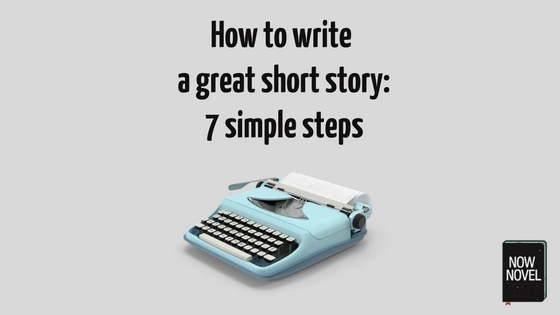There are many reasons to learn how to write a great short story, even if you consider yourself a novelist first. Short stories present many publishing opportunities in journals and magazines. A short story can also be a testing ground where you work out the central themes, conflicts and characters you will use in a longer work. Here are 7 steps to writing a short story like the greats:
First: How long is a short story exactly?
When writing a short story it’s a good idea to have a target length in mind. Short story publications and writing contests have strict minimum and maximum word count limits.
The average story length preferred by magazine and journal publishers is 5000 words or less. The prestigious Caine Prize for African Writing specifies in its short story submission requirements a length of between 3000 to 10,000 words. The Lorian Hemingway Short Story Competition, on the other hand, has a lower maximum word count requirement – 3500 words.
While short story length tends to hover around 3000 to 5000 in publishing, there’s nothing to say you can’t write a 40-page short story. If you hope to publish, though, remember to check submission length requirements before you start writing your story.
How to write a great short story: Your 7 steps
Step 1: Choose an interesting story premise that suits short story treatment
Some ideas are too novelistic to fit the length constraints of a short story. The story ideas that tend to work best contain a single crucial event, character epiphany, confrontation or twist.
Short story examples that fit this description include Faulkner’s ‘A Rose for Emily’ and Poe’s ‘The Tell-tale Heart’. In Faulkner’s story, the town recluse dies and the locals discover a grisly, macabre secret. In Poe’s story, a man who claims to have murdered another is driven to reveal himself to invesigating officers when he’s tormented by the sound of the dead man’s beating heart.
When choosing an idea for your short story, ask yourself:
- What will the central event or moment of my story be?
- How will I build up to this moment? In Faulkner’s story, we learn about Emily’s death at the start of the story, but our curiosity about her grows up until the grisly reveal as we are told about the curiosity of the townsoflk
Once you have your central story idea, knowing how to start a short story well is crucial:
Step 2: Start your you short story with an intriguing sentence that leaves questions
Whether you write short stories or novels, both require hooks that draw readers in. In short stories, this is especially important as brevity means that each part of the whole stands out that much more.
To learn how to write a great short story opening, study the greats. The best short story writers create opening lines that fill us with questions. Alice Munro (who won the Nobel and the Man Booker International Prize for her body of short stories) is a master of this.
Take, for example, the opening of Munro’s short story ‘Train’:
‘This is a slow train anyway, and it has slowed some more for the curve.’ Immediately we want to know why it is significant that the train is slow. That word ‘anyway’ is perplexing – it emerges in subsequent sentences that it is a rationalization. The focal character, Jackson, is contemplating jumping from the slow train in question.
To write a short story that readers love, you first need to draw readers in. Practice writing short story openings that leave questions.
Step 3: Create memorable core short story characters
Great short stories have memorable characters. In Poe’s ‘The Tell-Tale Heart,’ the unnamed narrator is full of character. He is neurotic, nervous, and continually defends himself as not being mad:
‘Now this is the point. You fancy me mad. Madmen know nothing. But you should have seen me. You should have seen how wisely I proceeded – with what caution – with what foresight – with what dissimulation I went to work!’
Besides giving your short story characters vivid voices (as Poe does), take time to develop them. Poe’s narrator goes from being worried by the old man’s eyes to dismembering him and being overcome by guilt. The character moves from sneaky, self-concealing behaviour to remorseful self-revelation.
To truly create fanastic short fiction characters, you need to know your characters inside out. This will help you distil your characters’ essential features and quirks. As Dennis Jerz and Kathy Kennedy say, ‘It is important to know way more about the character than you will ever use in the story.’ Some of the details they suggest you write down about your characters:
- What do they hate?
- What are their secrets?
- What are their strongest memories?
- Do they have any illnesses, phobias or nervous gestures? What are their faults?
To write a great short story, plan small character arcs like Poe that show how your main characters change due to the events of the story.
Step 4: Write meaningful character dialogue
Because there is less space for lengthy exposition in a short story, it’s doubly important to write impactful dialogue. All dialogue should contain information that grows readers’ understanding of your characters and/or the events of the story.
For example, in Munro’s short story ‘The Bear Came Over the Mountain’, about a man and his wife who is in the early stages of Alzheimer’s and is put in a home, Munro uses dialogue to great effect.
In an early part of the story, Grant takes Fiona a book on Iceland which she shows little interest in. Towards the end of the story, Grant visits Fiona and the following dialogue ensues:
[Fiona] said, “Look at this beautiful book I found. It’s about Iceland. You wouldn’t think they’d leave valuable books lying around in the rooms. But I think they’ve got the clothes mixed up – I never wear yellow.”
“Fiona,” he said.
“Are we all checked out now?” she said. He thought the brightness of her voice was wavering a little. “You’ve been gone a long time.”
In this dialogue, Munro shows the pathos of Fiona presenting the gift Grant had brought her with no recollection of this act. The dialogue conveys succinctly the change in the character, her increasingly sketchy memory. It subtly conveys the emotional impact of Fiona’s condition on her significant other, distilling the story of their relationship.
In the best short stories, besides crisp dialogue there is also often a potent sense of change:
Step 5: Show pivotal change
Change drives stories. When we talk about how to write a great short story, we’re also talking about how to write a great story, length aside. For a short story to deliver the same sense of journey as a novel, however, there needs to be a similar sense of development and change.
As we often repeat, the 5 ‘W’s’ of story – who, what, why, where, and when – can all change. The first two – who and what – can change more radicallly in a novel than a short story. In a novel, the narrator can change from chapter to chapter. By comparison, for unity of effect in short stories we often stick with a central narrator throughout the entire story.
In short stories, the ‘why’ often changes. The ‘twist in the tale’ type of ending (popularised by the American author O. Henry) is an example of this. In O Henry’s short story Mammon and the Archer, for example, a son bets with his father that love wins over money. The son proves this to his father by winning the hand of a girl he loves in marriage, but it turns out that the son’s advances aren’t why the girl accepts. His father pulled strings using his money to secure the arrangement, effectively winning the wager.
The ‘where’ of a short story changes less often. A novel might track an assassin’s travel around the globe, but is more common in short stories to see how things change in a fixed or limited setting. The ‘when’ is also typically more static.
At the same time, you can convey the illusion of time passing and a longer narrative frame in short stories using memory. This is something Alice Munro excels at – her story narrators often recall scenes from childhood, and these intersect with narration describing current experiences.
Step 6: Build to your story’s climax
In a novel-length work of fiction, there is space to build to the story’s end and thus there are many ways to arrange moments of tension, revelation as well as stretches of more leisurely digression.
Learning how to write a great short story requires becoming adept at condensing this building process. In a short space of time, you need to create a pull towards resolution. In Munro’s ‘The Bear Came Over the Mountain’, she achieves this building effect by showing Fiona’s worsening memory.
Munro’s story does something all great stories do: It follows its own internal logic. Early in the story, we realise something is afoot when Grant asks Fiona whether she’s been taking sleeping pills and she replies, ‘If I am I don’t remember.” In the subsequent paragraph, Munro writes ‘Vitamins didn’t help. She would stand in doorways trying to figure out where she was going.’ There is a cumulative sense of change that builds to the complications around Fiona’s extra-marital interest in another resident at the care home.
What Munro’s example shows is that a story doesn’t need murder or gripping action to be interesting. You can still create a strong sense of story by writing memorable characters, punchy dialogue, and developing your starting story scenario convincingly.
Step 7: Write a fitting story ending
We’ve talked elsewhere about writing a satisfying ending for a novel. In a short story, the ending also needs to bring together the strands of the story. Often, short story endings are either surprising (the ‘twist in the tale’) or convey a final irony.
In Roald Dahl’s famous short story ‘Lamb to the Slaughter’, for example, a woman bludgeons her husband to death with a frozen leg of lamb and the story culminates in her serving the evidence to the investigating officers. Munro achieves a bittersweet irony in ‘The Bear Came Over the Mountain’ in the final lines of dialogue between Fiona and Grant:
“You could have just driven away,” she said. “Just driven away without a care in the world and forsook me. Forsooken me. Forsaken.”
He kept his face against her white hair, her pink scalp, her sweetly shaped skull.
He said, “Not a chance.”
Munro conveys the irony that even while she is thanking her husband for not forsaking her, this is what Fiona is doing to him herself, involuntarily, due to her memory loss.
To write a great short story, make sure that your ending provides answers to central story questions and conveys a sense of final reflection on your core themes.
Do you want to improve your short fiction or try your hand at a novel? Find a central story idea, join the short stories group and get helpful feedback from the Now Novel community now.




5 replies on “How to write a great short story: 7 simple steps”
I am not sure how to seamlessly combine short stories about three to four different characters that work together. Please advise. Thanks
Hi PJ. Thanks for the question! It’s a little ambiguous in its wording – did you mean how to make the separate stories flow as a unit despite following different characters? I’d suggest looking at other writers who have written story cycles where the same characters recur. Sherlock Holmes by Sir Arthur Conan Doyle is a good example.
Hi: yes
[…] be able to write a great short story is one of the key signs that you are a competent writer. Some people disregard short story writing, […]
[…] gives this as one of 7 tips for writing a great short story in a blog post on Now […]